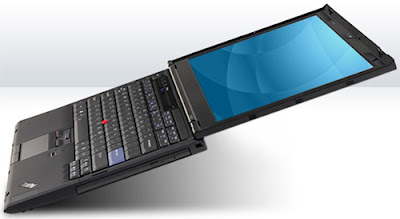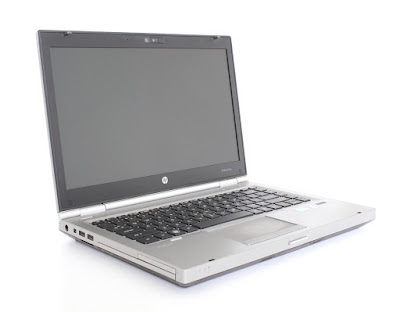Going back to the beginning, my very first laptop computer that is, I've always had a bit of an obsession with "ultra-portability" and the concept of the portable/mobile workstation. I'll define that here as being a computer and peripherals having the capability of doing jobs that are generally considered to be within the province of full-sized desktop computers. I'll have to say that I was able to get started in good style with the IBM ThinkPad 701c (sometimes known as the butterfly). As machine so small that a full-sized keyboard was too large for, and had to be able to fold and unfold into!


As cool and interesting as that machine was though, it wasn't really the whole story. I took the concept to another level by finding the IBM 5183 Portable Printer along with the Logitech Scanman II to pair with it. This gave me be the capability of pretty much doing anything I wanted, anywhere I wanted, without even an electrical outlet. If you're unfamiliar with the computer, it's really smaller than what the image would indicate. That screen is only 10.4"! So this whole rig pretty much fit in a regular sized computer bag and weighed no more than just a more normal sized laptop by itself. I was hooked!

In the years after that, my portable machines grew as they progressed from legendary 600, then on to the the "T" Series. I was happy with these machines, but often would lament the lack of extreme portability that the "Butterfly" had given me. Then one day the ThinkPad folks dropped the X300 bomb on us! When the price for them finally came back down to earth, I bought a nice used one several years ago.


This became the core of my "next-gen" portable workstation. It paired nicely with Canon LIDE scanner that I had at the time and I even dabbled in the Pentax Portajet thermal printer (the world's smallest printer). The idea received it's most significant use and "proof-of-concept" when tragically my mother-in-law passed away due a car accident during the holidays one year. I had the whole rig with me at the time since we were vacationing with my in-laws and I was scanning some family photos for them. That scanner got quite a workout putting together a memorial from old photographs for the funeral.
Around that time, I added another element to my little bag of tricks by adapting the recently acquired Android ThinkPad Tablet to work as a secondary screen to the laptop (which had been upgraded to the X301). This gave me a portable multi-monitor setup like I was used to at home.
The 3rd generation of my portable workstation came about when the X3xx machines gave way to the X1. On one hand, I gave up having a built-in optical drive (which I haven't missed at all), but on the other, I gained a much nicer (and larger at 14.1" vs. 13.3") screen (the X3xx machines had notoriously bad panels), but at a resolution (1366 x 768) much kinder to my aging eyes. Although it's a 2nd gen (Ivy Bridge) Core processor, and has other upgrades such as USB 3.0 as well; it's most important function is as the "core" (forgive the pun) to the new version of portable "eco-system" if you will.

Recently, I was to again add the ability to print on the move with the HP OfficeJet H470 printer. I actually gave about $30 (after shipping) for 2, H470s and 1, H460, along with power supplies for all three as well as 2 batteries. One of the H470s has an unresolved issue, but the other one works as does the H460 that I'll probably sell to defray the cost of the whole thing. A Bluetooth wireless module ($10) is on it's way from China to allow me to go fully wireless printing.
Of course there are other smaller items such as the Bluetooth travel mouse, the nVidia Shield tablet and the Wacom Bamboo pen digitizer that gives me other capabilites as well.


Those things are great, but the biggest change in this generation has to be the ability to bring massive storage to the portable realm. About a year ago, I picked up the Lenovo F800 "Multi-Drive". Essentially an access point, attached to a lithium-iom "power station", combined with a 1Tb hard drive, it gives me the ability to have a wireless NAS wherever I go. As if that wasn't enough, I picked up a Drobo Mini last summer and populated it with 4 laptop sized (2.5") drives (2, 1.5Tb & 2, 1Tb), giving me the capability to carry 5Tb of USB 3.0 attachable storage with me anywhere. This weekend, I put the 600Gb Intel 320 SSD from my wife's old laptop into the other bay of the X1. This combined with the mSATA, 480Gb SSD, gives me a total of around 1Tb of "onboard" storage, and 6Tb of either attached or wireless storage. If you'd have told me that I'd be able to do this affortably even 2 years ago; I'd have said that it was "crazy talk"!

That's a lot of cool portable stuff right!?! ....but there's more! Oh, I don't own any of it, but ..... one day..... What is it? It's the ThinkPad "Stack". What's the pieces in the Stack? One is a lithium-ion power station, another is a Bluetooth speaker, then you a portable access point, and of course, the last (so far) is a portable HDD. Each is about the size of one of those portable drives you can buy anywhere, but the cool thing about this is that they're all the same footprint and can connect to each other without wires or cables! OK; it doesn't do anything that I can't already do, but it does it in a much nicer way! I can be a little OCD.































